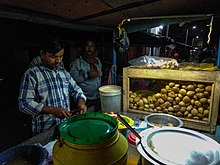Panipuri (originally known as jalapatra from Mahabharata times) (![]() pānīpūrī (help·info)), phuchka (
pānīpūrī (help·info)), phuchka (![]() fuchka (help·info)), gupchup, golgappa, or pani ke patashe is a type of snack originating in the Indian subcontinent, where it is an extremely common street food.
fuchka (help·info)), gupchup, golgappa, or pani ke patashe is a type of snack originating in the Indian subcontinent, where it is an extremely common street food.
Ingredients
Panipuri consists of a round hollow puri (a deep-fried crisp flatbread), filled with a mixture of flavored water (known as imli pani), tamarind chutney, chili powder, chaat masala, potato mash, onion, or chickpeas.
Fuchka (or fuska or puska) differs from panipuri in content and taste. It uses spiced mashed potatoes as the filling. It is tangy rather than sweetish while the water is sour and spicy.
Names

A vendor selling panipuri somewhere in Pakistan

Phuchka seller in Purulia, India.
Panipuri’s name varies depending on the region. In Maharashtra, it is known as Pani Puri; Haryana it is known as paani patashi; in Madhya Pradesh fulki; in Uttar Pradesh pani ke batashe/padake ; in Assam phuska/puska; Pakodi in parts of Gujarat, Gup-chup in Odisha, Andhra Pradesh, South Jharkhand, Chhattisgarh Phuchka in Bengal, Bihar and Nepal. It is popular by the name of Gol Gappa (/goːl.gapːaː/) in some parts of Northern India (particularly Delhi and Punjab) and Pakistan.
On 10 March 2005, “pani puri” was added to the Oxford English Dictionary.
History
Chaat is considered the predecessor of pani puri/ gol gappa. According to the culinary anthropologist Kurush Dalal, chaat originated in Northern Indian region of what is now Uttar Pradesh. Gol gappa originated In Indian subcontinent. He also noted that it possibly originated from Raj-Kachori: an accidentally-made smaller puri giving birth to pani puri. Pani puri spread to the rest of India mainly due to migration of people from one part of the country to another in the 20th century.
Gallery
-

-

-

-

-

-

Sooji Puri used in panipuri.
